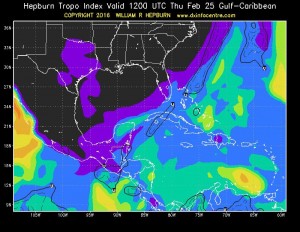
Green: Reception. Blue: Reception with severe interference Purple: Negative reception but should have picked it up Grey: May be have been US station same channel Yellow or Black: negative pickup (black too weak)

I’ll have a Venti Propaganda.
I had the chance to visit the Florida Keys recently, and you can guess what I was up to – hitting the beach to avoid AM interference from local electronics, so I could listen to Cuban radio stations!
I did a dial scan for both AM and FM sides, each with its own issues.
The math for daytime AM is pretty straightforward, it’s all groundwave so you can model power divided by distance squared. A rich vein of data is the FCC AM Query page. I pulled every AM signal within 450km of Key West and start whittling down against my notes. The main difficulty in going up against the FCC records is that… the FCC records are notoriously bad for international listings. They get Canada wrong on a regular basis (at least two times in recent memory, they completely dropped the ball watching out for Industry Canada assignments that impacted NPR signals in North Dakota), and Cuba is another story entirely. I’m pretty sure Cuba gives about zero flips for frequency coordinating with the US when we’ve still got blimp blasters in the Keys.
Some other radio fans managed to snag some data off of EcuRed and turn it into a semi-manageable transmitter site list, which I can also crossreference after updating the list with some distance data.
Another handicap is that I don’t speak Spanish, so I couldn’t glean much about those programs (though advertising seems exclusively American). The easy part is I don’t have to worry about skywave from Mexico or the Dominican Republic, or wherever. Since I couldn’t wait around to confirm callsigns, I’ll be poking around trying to confirm certain US stations in my model had Spanish programming around 1pm on the 25th. Once I have accounted for all the Florida-based Spanish-language stations, the remainder must be Cuban!
My radio rig is a 1994-era car stereo that’s in my Geo Metro, I’m not hauling any fancy Grundig or what have you. One thing about this radio is that, especially on AM, it tends to bleed on either side of a strong signal, so when I was taking my notes I ignored a lot of nearby stations that sounded the same. Yet, if what I’m reading now about the Cuban radio networks is right, there might have been more separate stations than I thought.
 The FM scan is more problematic. Applying the same method as the AM scan, oddly, is not as sound of a model. VHF signals are much more line-of-sight than AM, true, but at longer distances, especially over warm water, they are also subject to anomalous propagation through the atmosphere. Tropospheric Propagation has a big fanbase in the ham radio community, it’s the main way uber-nerds snag a TV signal from 300 miles away.
The FM scan is more problematic. Applying the same method as the AM scan, oddly, is not as sound of a model. VHF signals are much more line-of-sight than AM, true, but at longer distances, especially over warm water, they are also subject to anomalous propagation through the atmosphere. Tropospheric Propagation has a big fanbase in the ham radio community, it’s the main way uber-nerds snag a TV signal from 300 miles away.
According to the Tropo reports for noon on the 25th, there may have been a weak opening between the Keys and Cuba, and perhaps a hint more in the direction of Miami and the Bahamas.
Trying to sort out all the stations that might contribute to the FM dial readout will be tough, I’ll look at it more down the road. Still, I’m pretty happy to have confirmed I caught at least two or three of the main Cuban radio networks.